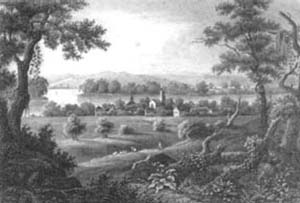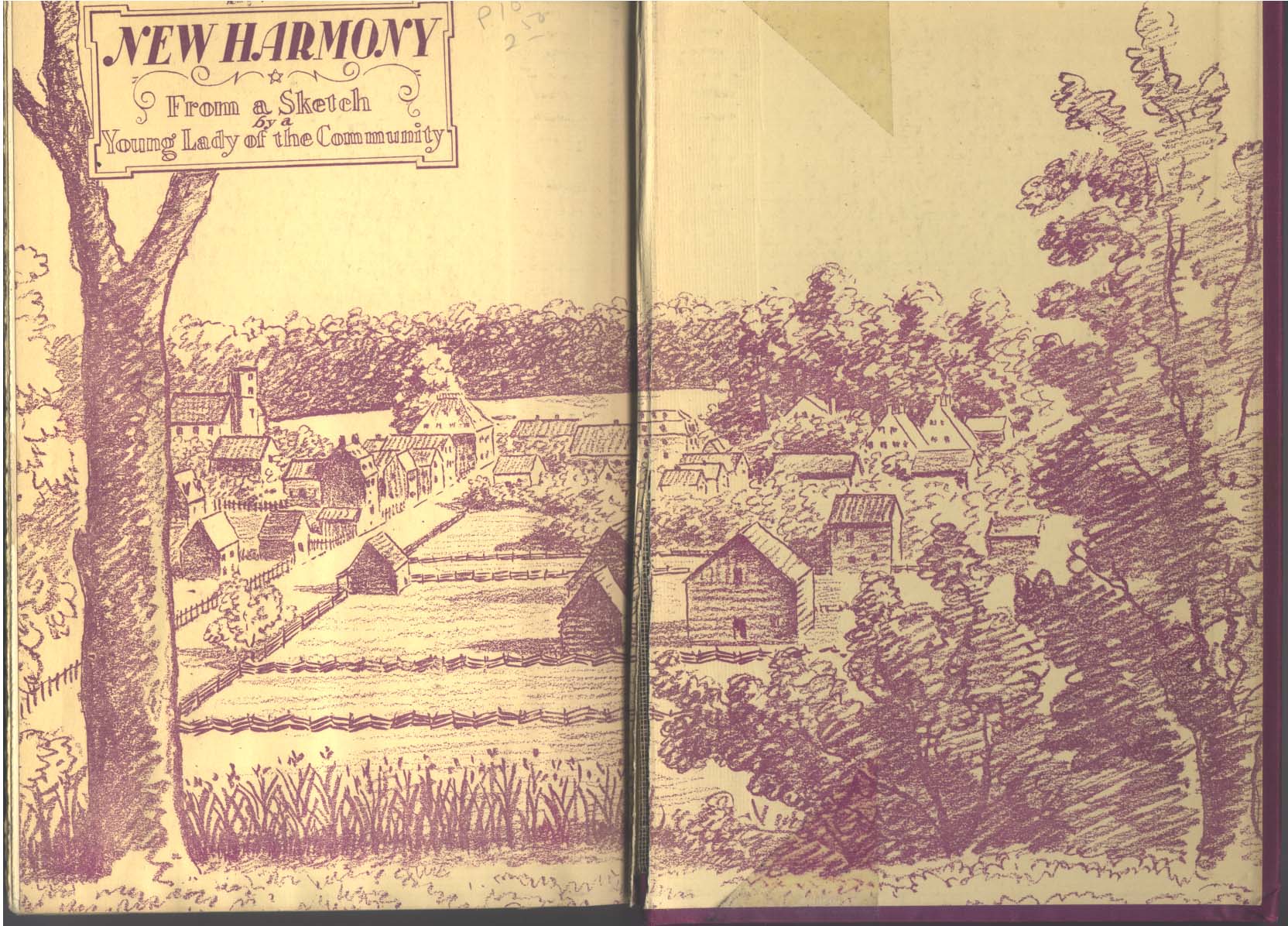Caroline Dale Snedeker was the author of children’s
novels, three of which were set in New Harmony, Indiana. She
grew up in this town, and has written novels about its settlement
from stories told to her by her grandmother. The original
community was set up as a communist society under George Rapp.
After ten years in Indiana, this community moved to Pennsylvania.
In 1825 the land was sold to Robert Owen, Snedeker’s
great-uncle. His hopes were to set up a utopian community
on this new land.

New Harmony
by the Wabash River |
Educated men and woman floated down the Ohio
River on their way to New Harmony in a boat that came to be
known as the Boatload of Knowledge. The community started
to become “inhabited by university men, writers, theorists,
humanitarians, and naturalists. They had come from London,
Edinboro, Paris, and had brought with them their scholarly
world” (Indiana Historical Society Publications 151).
Snedeker’s stories are based on the lives
of the inhabitants of the newly settled New Harmony. She is
very proud of her strong connection to her hometown. She wrote
stories based on real people and the real town in Posey County.
In her novels Snedeker gives us quick glimpses of the landscapes
of New Harmony. The
Beckoning Road, captured the
experience of people in the Northeast traveling to New Harmony
after they caught word that Robert Owen had purchased the
land and was developing settlements. As the families went
down the Ohio
River, they took in the beauty and amazement
of the surroundings. In The Beckoning Road Snedeker
writes of what one of the children on the boat saw when looking
overboard:
As far as Dencey could see was no human habitation.
Just the hills with the gray winter woods mounting them,
mounting to the tops and flowing over into unending forest.
Now she was passing down between the hills, so full of growth
and tangle that no man might penetrate them. Only snakes
and foxes knew that way. The Ohio of that day was not broader
than now, but it seemed broader. Solitary, dominating the
whole landscape. The forests were its possession, the hills
its recent making as it swept on its huge, inevitable curves
toward the sea. Dencey was awed, almost frightened. (155)

Location of
New Harmony in southern Indiana |
Snedeker captures the excitement and hopefulness
of the travelers as they are entering newly explored land.
They have only heard stories of the land that they are about
to make their home, and they are excited to see the new
terrain.
When writing about the journey down the river
in The Beckoning Road Snedeker shows appreciation
for the quiet and tranquil features of the river. She writes
about a family docking their boat in the evening at Anderson’s
Ferry on the river shore of southern Indiana. The description
states: “Golden clouds hung in the west and lofty sprays
of golden light. The trees on the farther shore were scarcely
visible, hidden in lavender mist. But, strangely, every tree
shone downward, distinct in the water. A sweet underworld
of silence” (168).
Though the people coming to New Harmony were
probably somewhat anxious about moving their homes, they were
comforted by the fact that New Harmony had already once been
settled. George Rapp and his people had left their buildings,
roads, and farms. In an excerpt from The
Town of the Fearless
Snedeker describes what was left behind by Rapp as “a
town with an established trade down two great rivers, a town
with growing orchards, prosperous farms, flocks of sheep and
cows” (202).

Drawing of New
Harmony |
Robert Owen and his people were moving in to
a built town, but they were making it their own utopian society.
The surrounding forest and Wabash River were perfect vistas
for the theorists, writers, and naturalists that were moving
to the town. In The Beckoning Road, Dencey, a little
girl traveling to New Harmony, describes her first glimpse
of the town when she calls it “the little town nestling
in its sunny valley by the Wabash” (180).
The tranquil and beautiful surroundings of New
Harmony seem like they would have been an ideal location for
a utopian society. It seemed like a place where one could
go into the forest or down by the Wabash and
collect his/her thoughts. The quick
glances of the surrounding landscape
of
New Harmony that Snedeker describes
in her novels appear to be places
where the utopia-seeking citizens
of the community
could go for contemplation and
relaxation. The site of New Harmony
was probably partly chosen for
this reason, to create
a serene and natural place for
learning and living.
--KLP
Sources: Firestone,
Clarke B. Sycamore Shores. Robert M.
McBride & Company. New
York: 1936.
Indiana Historical
Society Publications. Volume 14. The
Bobbs-Merrill
Company.
Indianapolis:
1944.
Snedeker, Caroline
Dale. The Beckoning Road. The Junior
Literary Guild, Inc. New York:1929.
Snedeker, Caroline
Dale. The Town of the Fearless. Doubleday,
Doran & Company
Inc. Garden City: 1931.
Scientists,
Educators, Writers & Artists. 4 December
2003. <http://faculty.evansville.edu/ck6/bstud/nh.html>.
Links:
Snedeker - Feminist
author
|




